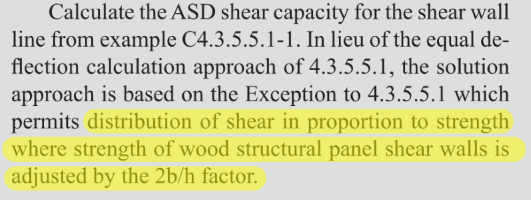masterdesign
Structural
When using the exception to deformation compatibility for in plane shear distribution, do you apply the capacity reduction for high aspect ratio shear walls (h/b>2) after or before force distribution?
Assume all shear walls in a line are of the same construction.
If you apply the capacity reduction to high aspect ratio shear walls after force distribution, you distribute based on wall length since all walls have the same unit shear capacity. This equates to the traditional method noted in Breyer. Then you check actual shear vs allowable shear. Actual shear is the same in all walls. Allowable shear is reduced for the the high aspect ratio shear walls (h/b>2). That is how it is shown in this APA presentation.
However, I believe you need to apply the capacity reduction to high aspect ratio shear walls (h/b>2) before force distribution. See excerpt from 2021 SPDWS example C4.3.5.5.1-2 below.

I'm thinking something like this:
ASD design
V wind = 2000 #
15/32" sheath, 8d common, 6" edge nailing
v allow = 730/2 = 365 plf
Wall 1
h = 8 ft
b = 8 ft
h/b = 1.00 < 2
No capacity reduction
Design capacity = 8*365 = 2920 #
Wall 2
h = 8 ft
b = 3 ft
h/b = 2.67 > 2
Capacity reduction = 2*3/8 = 0.75
Design capacity = 3*365*0.75 = 821 #
Distribute forces based on design capacity
V1 = 2000*2920/(2920+821) = 1561 #
V2 = 2000*821/(2920+821) = 439 #
v1 = 1561/8 = 195 plf < 365 plf ok
v2 = 439/3 = 146 plf < 0.75*365 = 274 plf ok
Assume all shear walls in a line are of the same construction.
If you apply the capacity reduction to high aspect ratio shear walls after force distribution, you distribute based on wall length since all walls have the same unit shear capacity. This equates to the traditional method noted in Breyer. Then you check actual shear vs allowable shear. Actual shear is the same in all walls. Allowable shear is reduced for the the high aspect ratio shear walls (h/b>2). That is how it is shown in this APA presentation.
However, I believe you need to apply the capacity reduction to high aspect ratio shear walls (h/b>2) before force distribution. See excerpt from 2021 SPDWS example C4.3.5.5.1-2 below.

I'm thinking something like this:
ASD design
V wind = 2000 #
15/32" sheath, 8d common, 6" edge nailing
v allow = 730/2 = 365 plf
Wall 1
h = 8 ft
b = 8 ft
h/b = 1.00 < 2
No capacity reduction
Design capacity = 8*365 = 2920 #
Wall 2
h = 8 ft
b = 3 ft
h/b = 2.67 > 2
Capacity reduction = 2*3/8 = 0.75
Design capacity = 3*365*0.75 = 821 #
Distribute forces based on design capacity
V1 = 2000*2920/(2920+821) = 1561 #
V2 = 2000*821/(2920+821) = 439 #
v1 = 1561/8 = 195 plf < 365 plf ok
v2 = 439/3 = 146 plf < 0.75*365 = 274 plf ok
